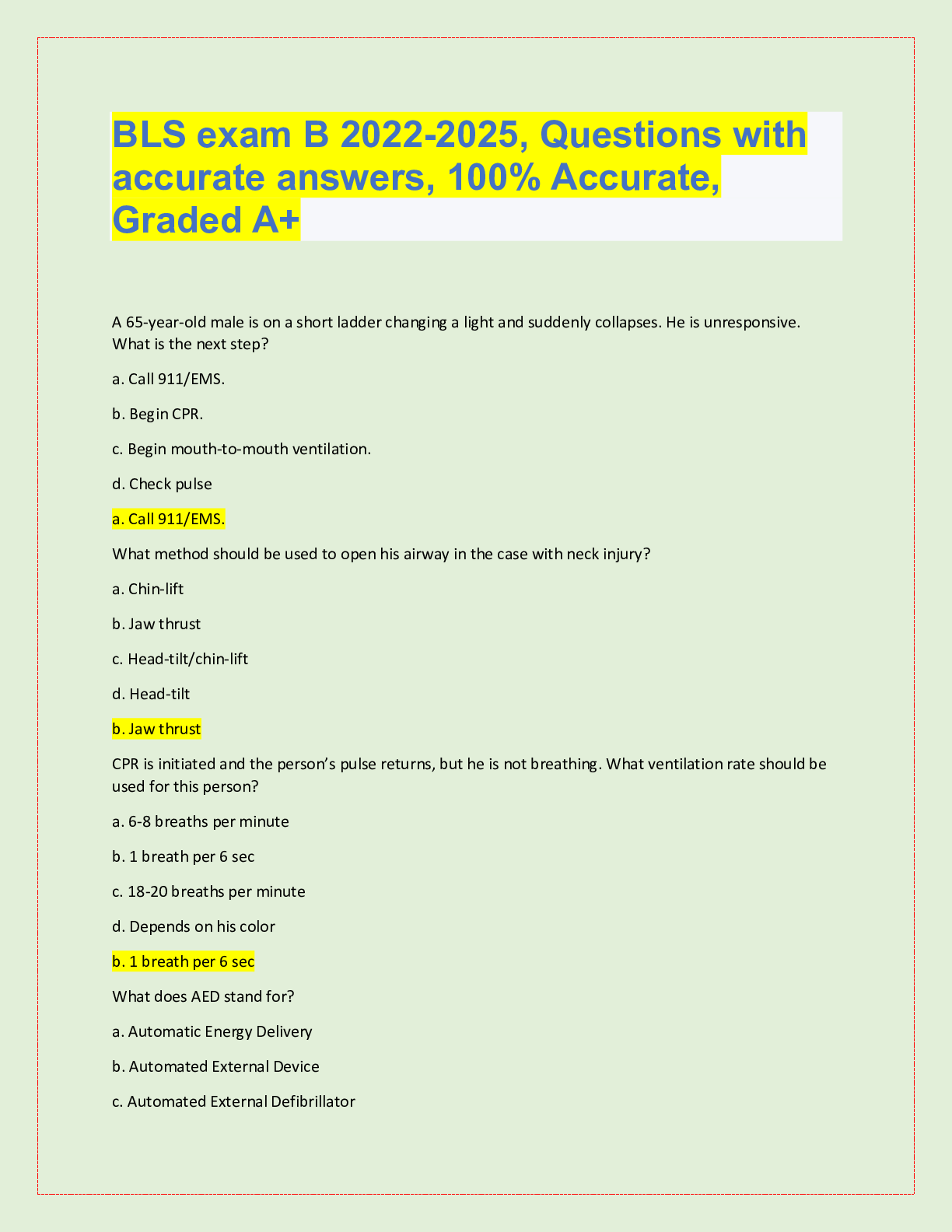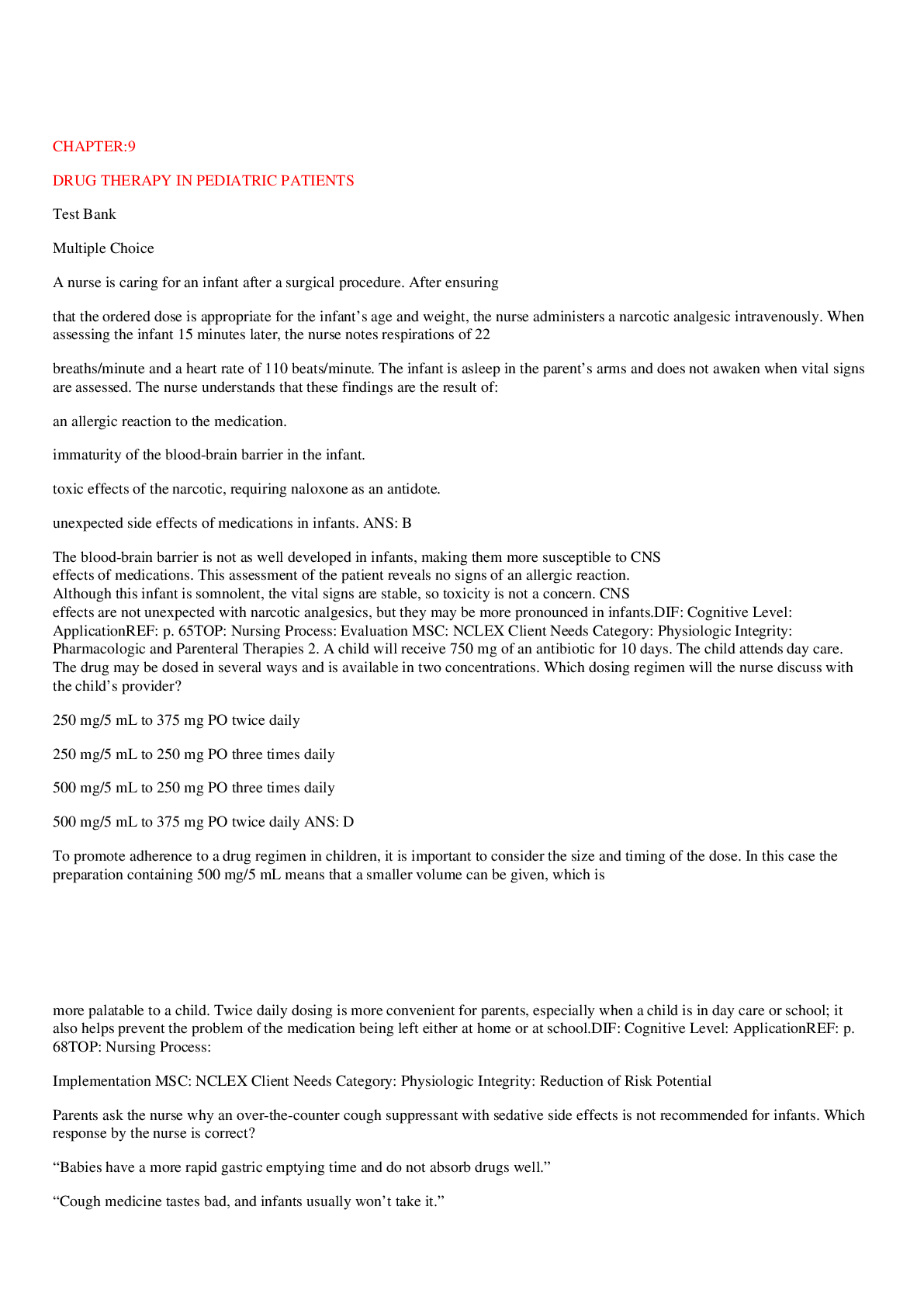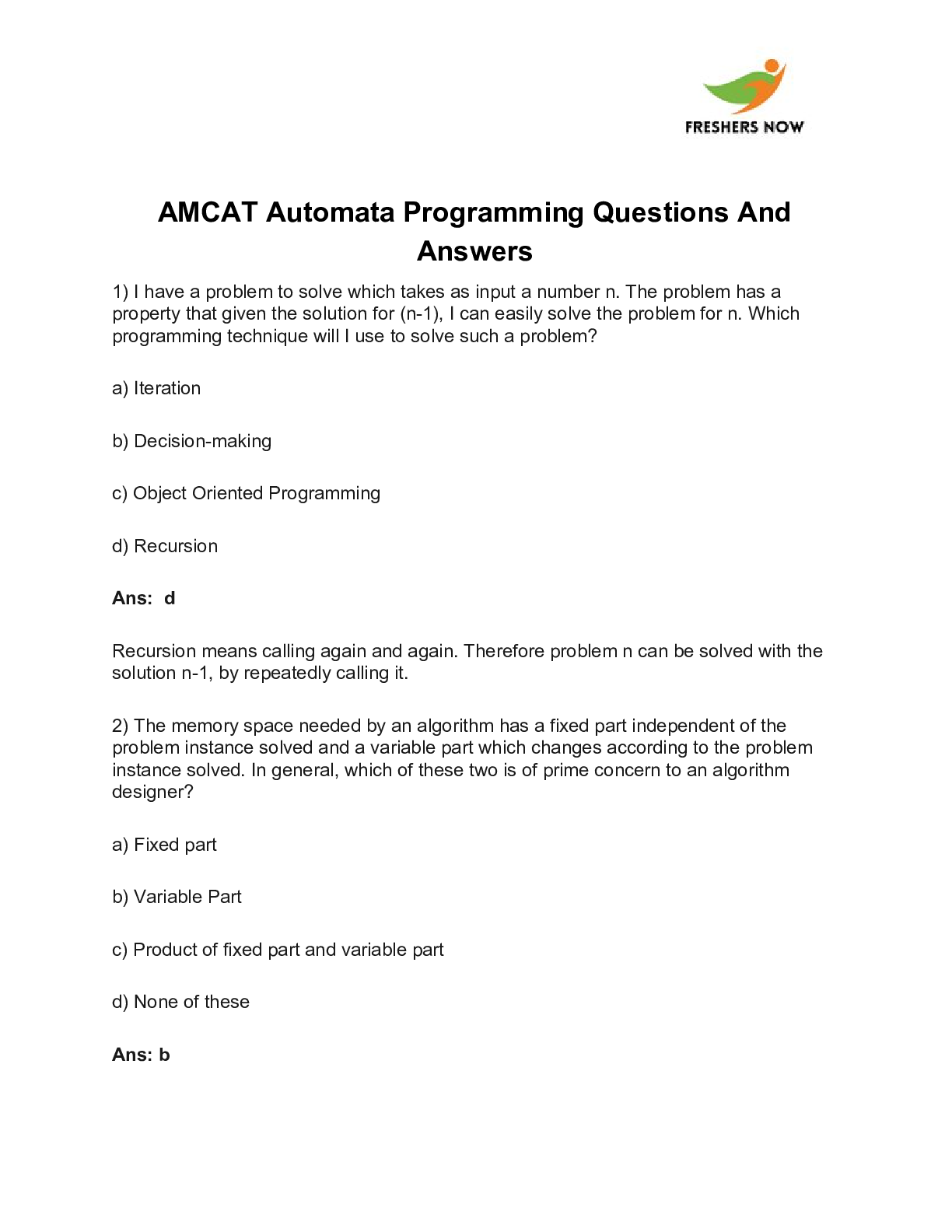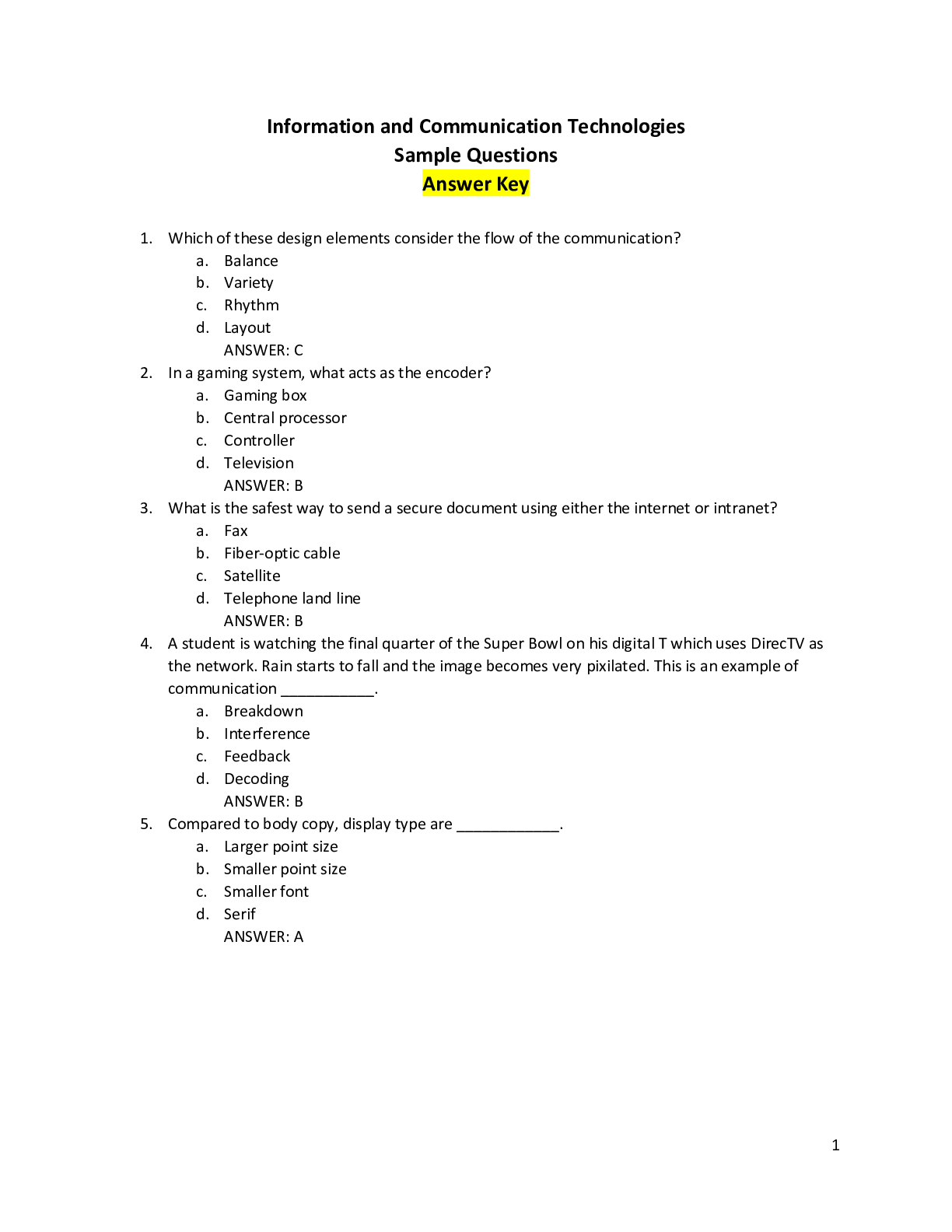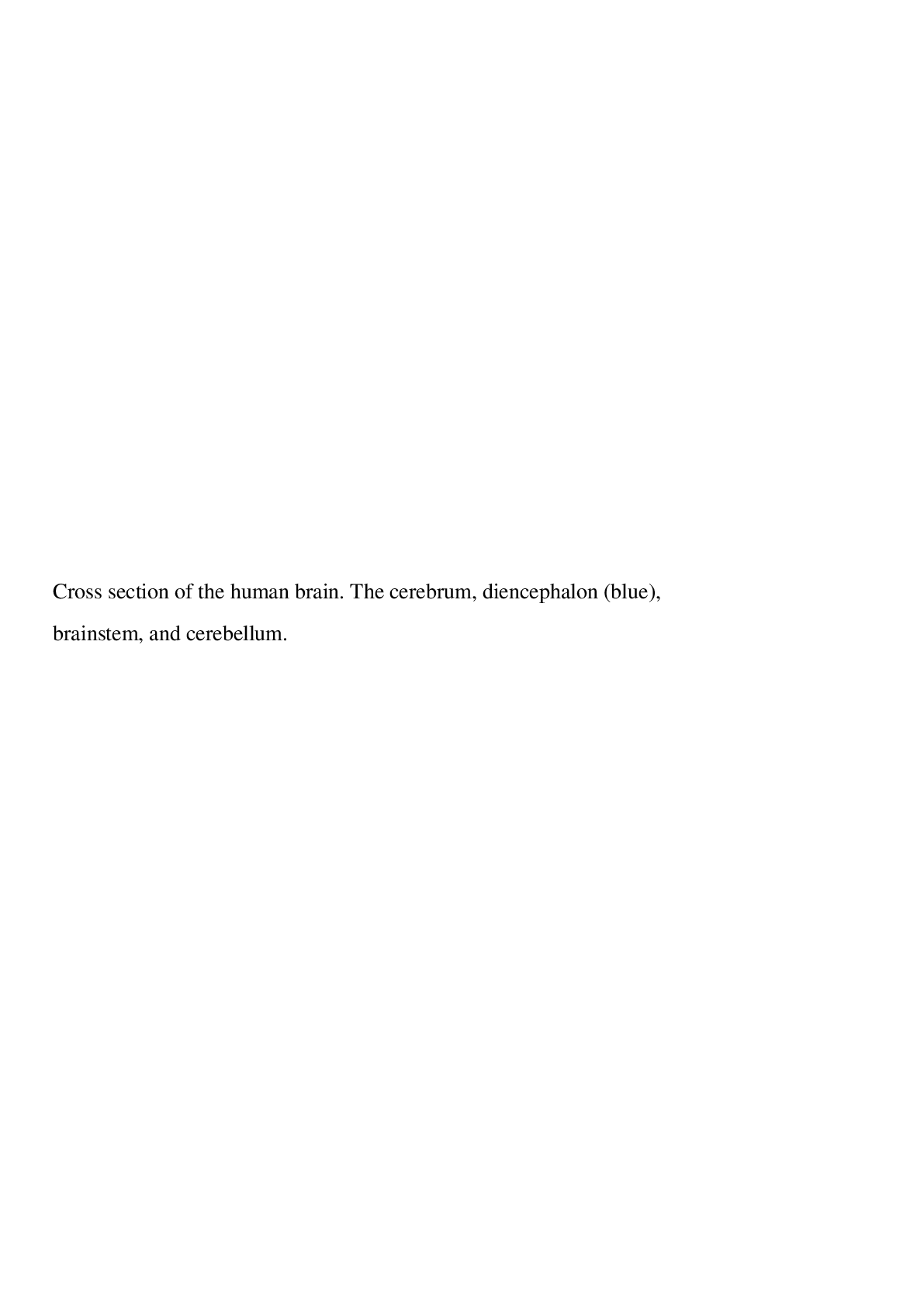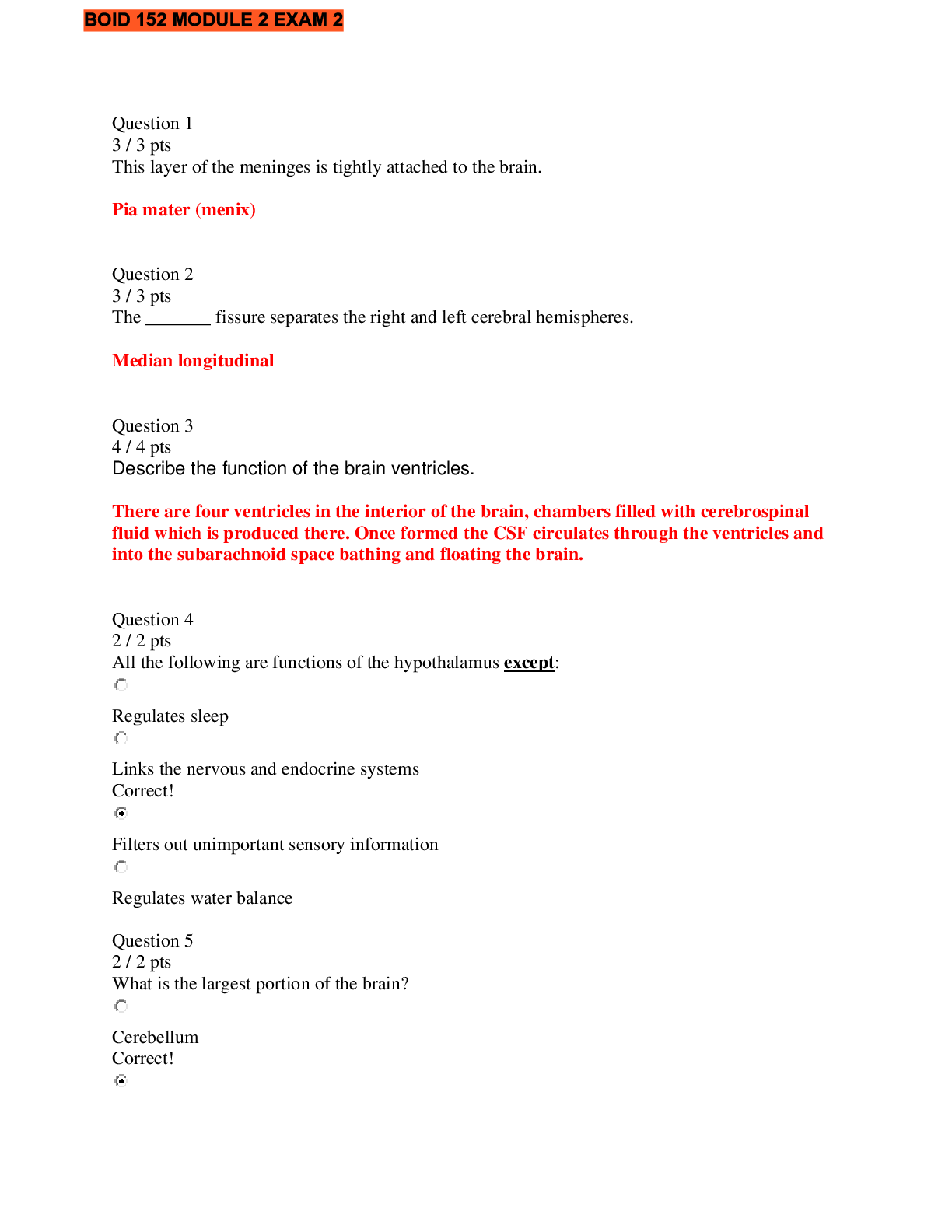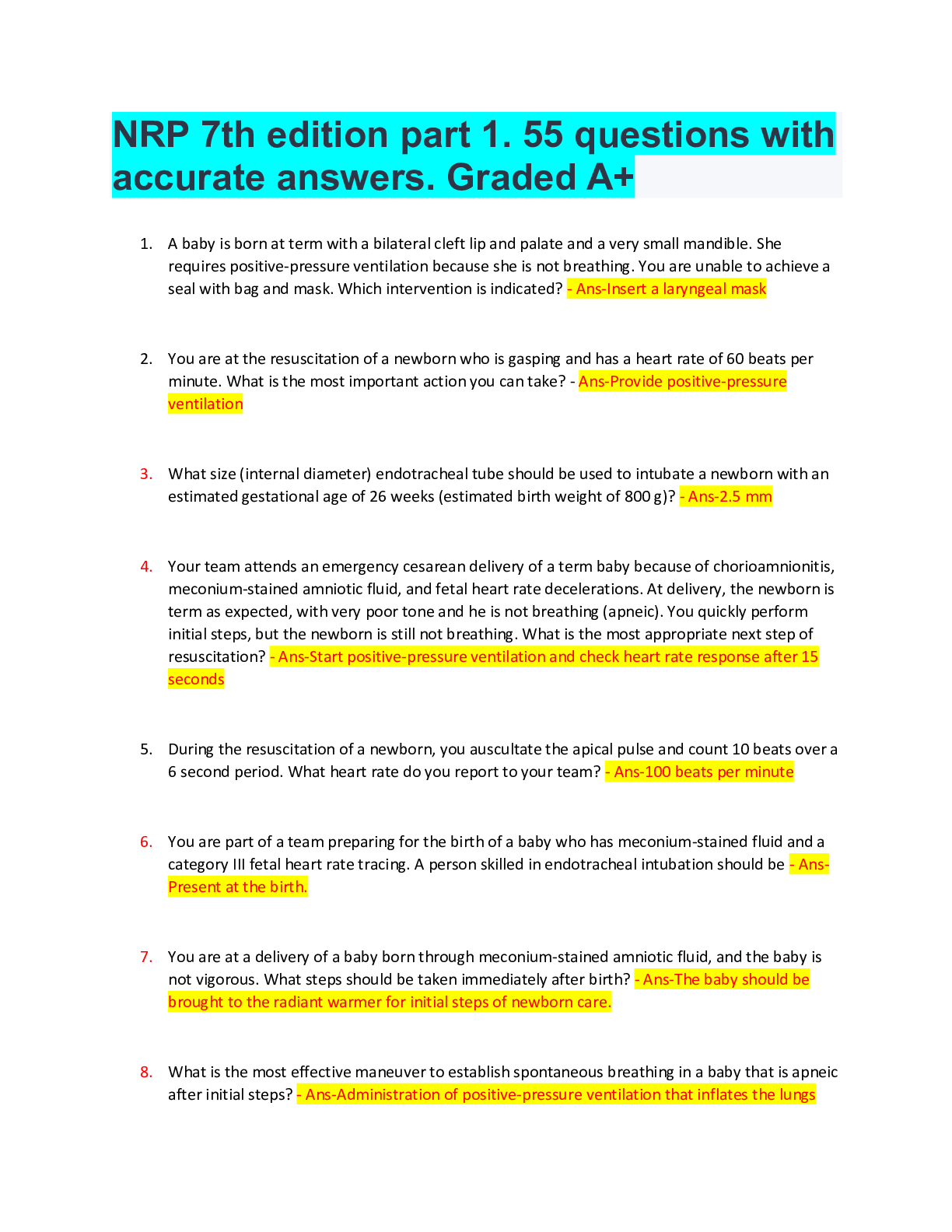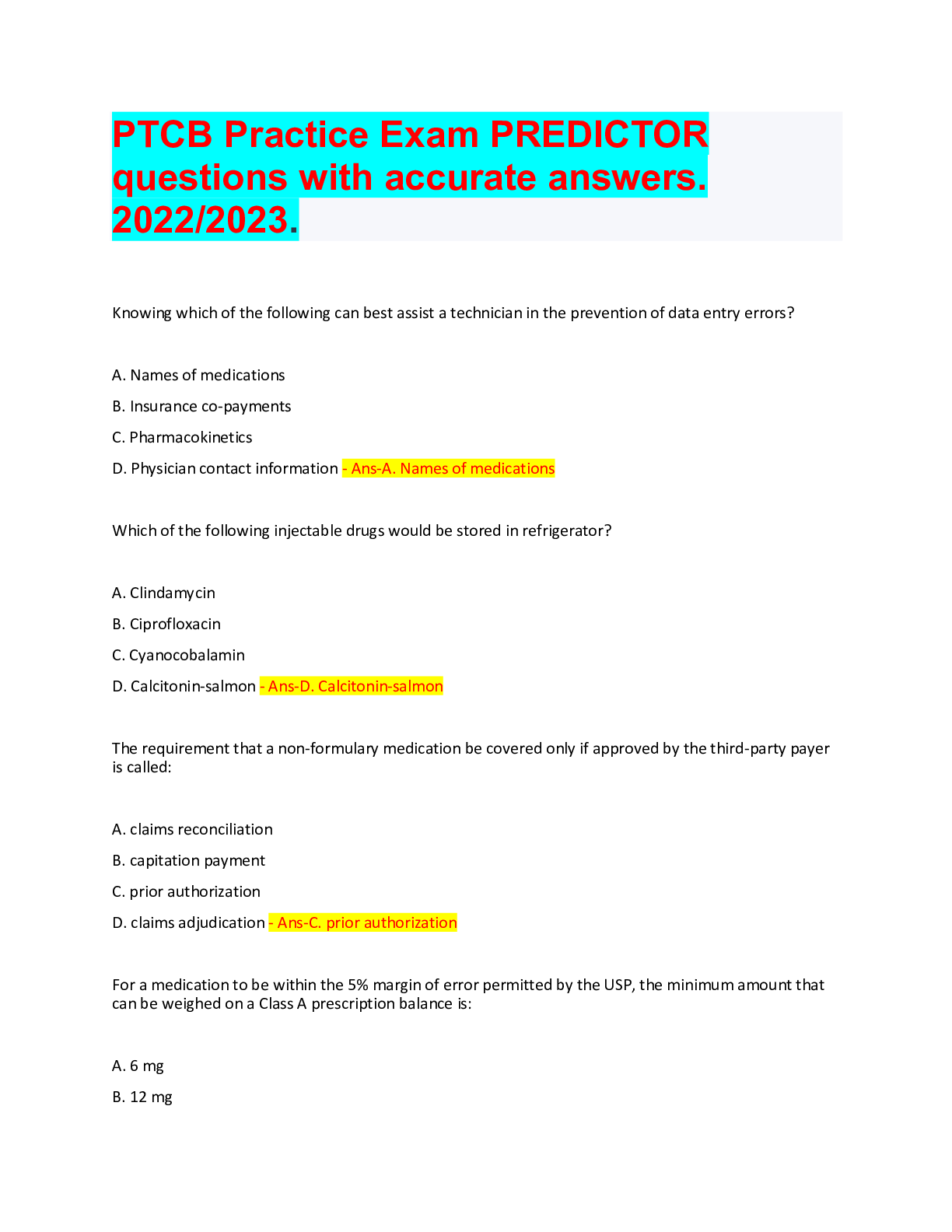Health Care > QUESTIONS & ANSWERS > CH 6 VA State and Health Exam Questions with accurate answers. 100% verified. Rated A (All)
CH 6 VA State and Health Exam Questions with accurate answers. 100% verified. Rated A
Document Content and Description Below
CH 6 VA State and Health Exam Questions with accurate answers. 100% verified. Rated A Todd has been informed that he has a hernia that requires repair. When Todd researches the cost, he learns th... at his insurance plan will cover 200 points worth of surgical expenses. Each point represents $10, which means that $2000 of his surgery will be covered by his insurance plan. What system is Todd's insurance company using? A) Conversion factor B) Relative value C) Basic Surgical D) Point-based medical - ✔✔B) Relative value The HMO Act of 1973 required employers to offer an HMO plan as an alternative to regular health plans if the company had more than 25 employees. How was this plan since changed? A) The minimum number of employees has decreased. B) The minimum number of employees has increased. C) Employers are no longer forced to offer HMO plans. D) The source of funding has changed. - ✔✔C) Employers are no longer forced to offer HMO plans. The corridor deductible derives its name from the fact that it is applied between the basic coverage and the A) Major medical coverage B) Comprehensive expense coverage C) Interval expense coverage D) Limited coverage - ✔✔A) Major medical coverage Don has both a basic expense and major medical policy. He is injured in an accident, which requires several major surgeries. This quickly exhausts Don's basic expense policy. What must Don do before his major medical policy can pick up where the basic expense policy left off? A) Submit written notification to his major medical insurance company B) Pay a special deductible on his major medical policy C) Wait 6 months in order to be covered again D) Nothing needs to be done. The hospital's billing staff will make the appropriate arrangements - ✔✔B) Pay a special deductible on his major medical policy Which of the following is NOT covered by Health Maintenance Organizations (HMOs)? A) Immunizations B) Routine physicals C) Well-baby care D) Elective services - ✔✔D) Elective services Another term used to describe "no deductible" is A) First-dollar basis. B) Comprehensive. C) Total coverage. D) Immediate cooperative. - ✔✔A) First-dollar basis. Which of the following provides coverage on a first-dollar basis? A) Basic expense B) Accident expense C) Supplementary major medical D) Limited major medical - ✔✔A) Basic expense Which of the following does NOT describe the principal goal of a Preferred Provider Organization? A) Provide the subscriber a choice of physicians B) Provide the subscriber a choice of hospitals C) Provide medical services at a reduced cost D) Provide medical services only from physicians in the network - ✔✔D) Provide medical services only from physicians in the network How does a member of an HMO see a specialist? A) The primary care physician refers the member. B) The insurer chooses the specialist. C) HMOs do not cover specialist. D) The member is allowed to choose his/her own specialist/ - ✔✔A) The primary care physician refers the member. When health care insurers negotiate contracts with health care providers or physicians to provide health care services for subscribers at a favorable cost, it is called A) Managed care. B) Indemnity plans C) Point of Service Plans (POS) D) Preferred Provider Organization (PPO) - ✔✔D) Preferred Provider Organization (PPO) Which of the following is true regarding inpatient hospital care for HMO members? A) Services for treatment of mental disorders are unlimited. B) Inpatient hospital care not part of HMO services. C) Care can be provided outside of the service area. D) Care can only be provided in the service area. - ✔✔C) Care can be provided outside of the service area. What is NOT a benefit of a POS plan? A) IT allows the employee to use an HMO provided doctor. B) It allows the employee to use a doctor not covered under the HMO. C) With the Point-Of-Service plan the employees do not have to make a decision between the HMO or PPO plans that lock them in. D) It allows guaranteed acceptance of all applicant.s - ✔✔D) It allows guaranteed acceptance of all applicant.s Which of the following is NOT an advantage of an HRA for an emplyoer? A) Employer contributions are tax-deductible. B) HRAs give smaller employers an opportunity compete with larger employers in the benefits offered to employees C) HRAs permit an employer to reduce health plan cost by coupling the HRA with a high-deductible ( and usually lower-cost) health plan D) HRAs are defined benefit programs - ✔✔D) HRAs are defined benefit programs When an employee covered under a health reimbursement account changes employers, the HRA A) Stays with the employer B) Follows the employee C) Returns to the insurer D) Is split between the employee and employer - ✔✔A) Stays with the employer Regarding a PPO, which of the following is correct when selecting a primary care physician? A) The insured may choose medical providers not found on the preferred list and still retain coverage. B) The insured is allowed to receive care from any provider, but if the insured selects a PPO provider the insured will realize lowed out-of-pocket costs. C) If a non-network provider is used, the insured's out-of-pocket costs will be higher. D) All of the above are correct - ✔✔D) All of the above are correct Which of the following is NOT true regarding a flexible spending account? A) It operates on "use-or-lose: basis. B) It provides an opportunity to receive benefits on a pretax basis C) It is a cafeteria plan D) It does not have limits on contributions - ✔✔D) It does not have limits on contributions If your health care plan has characteristics of an HMO and PPO, what type of plan do you have? A) FSA B) POS C) HIPAA D) MET - ✔✔B) POS What happens if a non-member physician is utilized under the Point-Of-Service plan? A) The attending physician will be paid a fee for service, but the member patient will have to pay a high coinsurance amount of percentage for the privilege. B) The non-member physician will be paid a fee for service C) The non-member physician will be paid a fee for service, but the member patient will be penalized per visit on his/her monthly premium. D) The member patient will have to pay all costs out-of-pocket. - ✔✔A) The attending physician will be paid a fee for service, but the member patient will have to pay a high coinsurance amount of percentage for the privilege. Can an individual who belongs to a POS plan use an out-of-network physician? A) Yes, but they must use the POS physician first B) Yes, but they must the HMO physician first C) Yes, and they may use any preferred physician, even if not part of the HMO D) NO - ✔✔C) Yes, and they may use any preferred physician, even if not part of the HMO Your client wants to know what the tax implication are for contributions to a Health Savings Account. You should advise her that contributions are A) Tax deductible. B) Subject to personal income taxes. C) Post-tax dollars. D) Subject to capital gains taxes - ✔✔A) Tax deductible. At what age may an individual make withdrawal from an HSA for nonhealth purposes without being penalized? A) 65 B) 62 C) 59.5 D) 55 - ✔✔A) 65 Jim is covered by a high deductible health plan. He makes regular contributions to this HSA. How are those contributions treated in regards to taxation? A) The contributions are tax-deductible B) The contributions are considered pre-tax C) The contributions are not deductible D) The contributions are taxed as income - ✔✔A) The contributions are tax-deductible To be eligible for a Health Savings Account, an individual must be covered by a A) High-deductible health plan. B) Low-deductible health plan. C) Nondeductible health plan. D) Health plan with no deductible. - ✔✔A) High-deductible health plan. Assuming that all of the following people are covered by a High Deductible Health Plan and are not claimed as dependents on anyone's tax returns, which would NOT be eligible for a health Savings Account? A) Jenny is 60 and also has a long-term care insurance plan. B) Joe is 50 and is not covered by any other health insurance. C) Amanda is 67 and is covered by basic medical expense policy. D) Andy is 55 and is covered under a dental care policy. - ✔✔C) Amanda is 67 and is covered by basic medical expense policy. An HSA holder who is 65 years old decides to use the money in the account for a nonhealth expense. Which of the following is true? A) There will be a tax and a 20% penalty. B) There will be a 20% penalty. C) There will be a tax. D) There will be no taxes and no penalties. - ✔✔C) There will be a tax. Assume that the insured owns a Major Medical policy with a $2,00 deductible, an 80/20 coinsurance and $15,000 stop loss limit. The insured suffered covered losses of $10,000. How much will the insurance company pay for the claim? A) $10,000 B) $6,400 C) $3,600 D) $8,000 - ✔✔B) $6,400 HSAs are designed to A) Help individuals save for qualified health expenses. [Show More]
Last updated: 2 years ago
Preview 1 out of 15 pages

Buy this document to get the full access instantly
Instant Download Access after purchase
Buy NowInstant download
We Accept:

Also available in bundle (1)
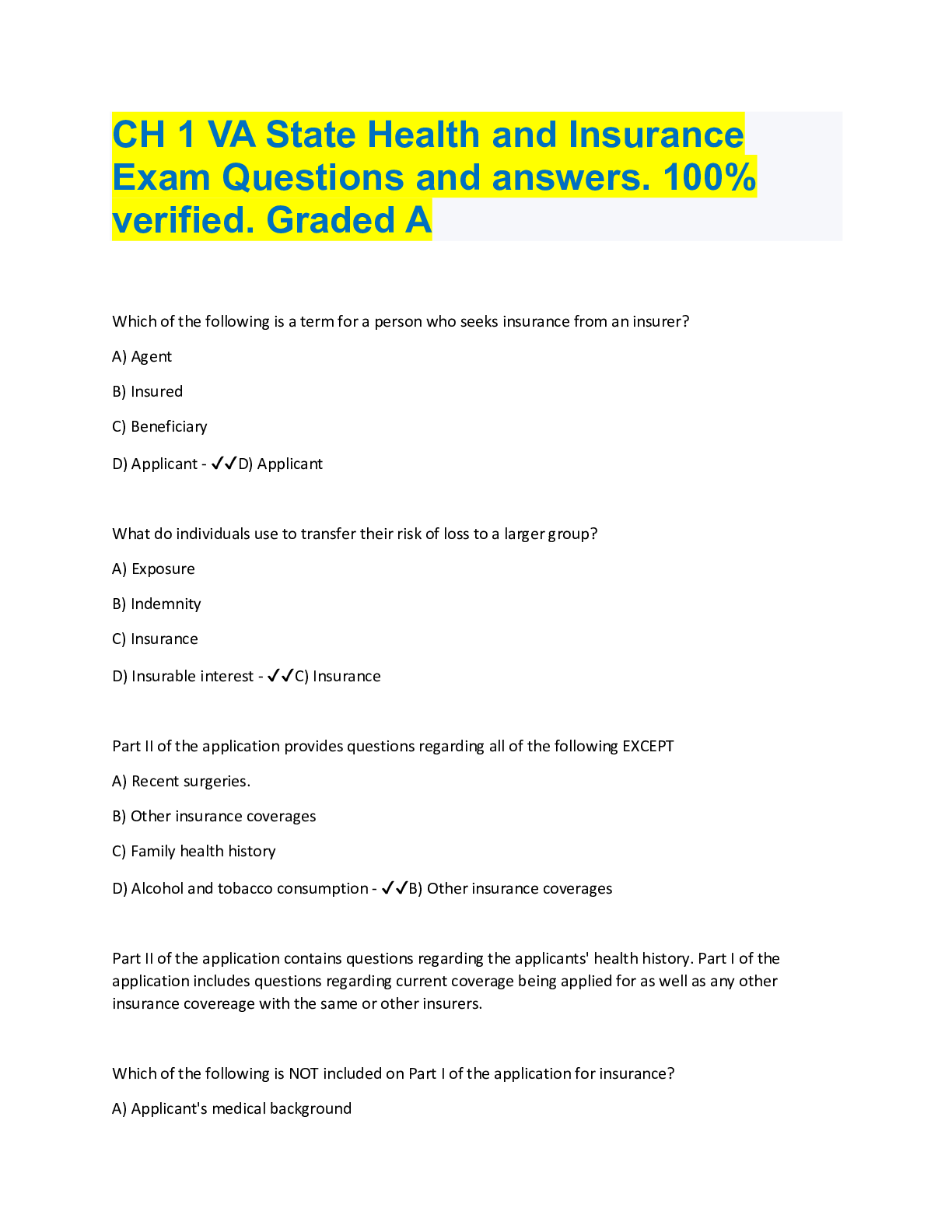
ALL VA CHAPTERS Questions with accurate answers,100% verified, EASY WAY TO PASS.
ALL YOU NEED TO PASS THE CH VA QUESTIONS ALL VA CHAPTERS Questions with accurate answers,100% verified, EASY WAY TO PASS.
By Topmark 2 years ago
$32
14
Reviews( 0 )
$8.00
Can't find what you want? Try our AI powered Search
Document information
Connected school, study & course
About the document
Uploaded On
Oct 13, 2022
Number of pages
15
Written in
Additional information
This document has been written for:
Uploaded
Oct 13, 2022
Downloads
0
Views
127

